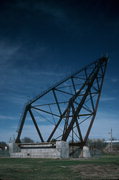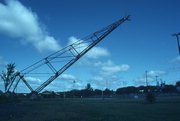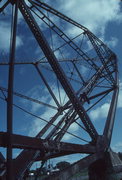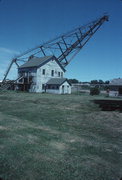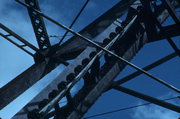Property Record
121 Park Rd
Architecture and History Inventory
| Historic Name: | Cornell Pulpwood Stacker |
|---|---|
| Other Name: | Mill Yard Park, Cornell Hydro |
| Contributing: | |
| Reference Number: | 31496 |
| Location (Address): | 121 Park Rd |
|---|---|
| County: | Chippewa |
| City: | Cornell |
| Township/Village: | |
| Unincorporated Community: | |
| Town: | |
| Range: | |
| Direction: | |
| Section: | |
| Quarter Section: | |
| Quarter/Quarter Section: |
| Year Built: | 1911 |
|---|---|
| Additions: | |
| Survey Date: | 19922019 |
| Historic Use: | machinery |
| Architectural Style: | NA (unknown or not a building) |
| Structural System: | |
| Wall Material: | Metal |
| Architect: | Joor Engineering Company |
| Other Buildings On Site: | |
| Demolished?: | No |
| Demolished Date: |
| National/State Register Listing Name: | Cornell Pulpwood Stacker |
|---|---|
| National Register Listing Date: | 12/23/1993 |
| State Register Listing Date: | 7/9/1993 |
| National Register Multiple Property Name: |
| Additional Information: | Two 'site files' (Cornell Wood Products Company) and (Cornell Wood Products Company Historic District) exist for this property. They contain additional information such as correspondence, newspaper clippings, or historical information. They are public records and may be viewed in person at the State Historical Society, Division of Historic Preservation. What local wags call the “Eiffel Tower of the North” is actually a reminder of the increasing mechanization that marked Wisconsin’s early-twentieth-century paper industry. Designed by an English firm, fabricated in Minneapolis, and assembled on site in 1912, the stacker was once part of a large mill complex, the Cornell Wood Products Company. Without a stacking machine, the company would have needed many laborers to load logs into storage booms floating in water. With the stacker, a mere handful of workers could stockpile the pulpwood in a giant stack on land. The stacker consists of two trapezoidal steel trusses, tied together by struts and braces, rising at a forty-five-degree angle from a concrete-pier base and converging at a tip 175 feet above the ground. Mounted at the top, an electric motor pulled the conveyor cable, a one-inch wire with iron discs attached every two feet. The conveyor carried two-foot logs up a V-shaped metal trough, then dumped them through chutes onto the top of the stack. The chutes could be adjusted to build the storage pile higher. When the logs were needed, they would be unstacked and floated through sluices (remnants of these waterways survive in Mill Yard Park) to the nearby debarking mill. By the 1920s many firms had turned to smaller, mobile devices for stacking wood, but this apparatus remained in use until 1971, when modern hydraulics rendered it obsolete. It may be the only structure of its kind left in the United States. Wisconsin’s paper industry first boomed in the Fox River Valley in the 1870s, but by the 1890s paper mills also sprang up along the Wisconsin River and here on the Chippewa, where they eagerly consumed the small softwood trees that the voracious logging industry had left behind. By the early twentieth century, thanks in part to technology like the Cornell stacker, Wisconsin ranked third among states in pulpwood and paper production. Paper remains a major industry in some parts of the state, but no longer in Cornell, which explains why this once-clamorous industrial site is now a quiet riverside park. 2019: Historically associated with the Cornell Wood Products Company located south at 50 Bridge Street. |
|---|---|
| Bibliographic References: | EAU CLAIRE LEADER TELEGRAM 10/9/1994. CORNELL AND LAKE HOLCOMBE COURIER 9/14/1995. CHIPPEWA FALLS HERALD TELEGRAM 12/11/1995. LADYSMITH NEWS 12/28/1995. Buildings of Wisconsin manuscript. |
| Wisconsin Architecture and History Inventory, State Historic Preservation Office, Wisconsin Historical Society, Madison, Wisconsin |

